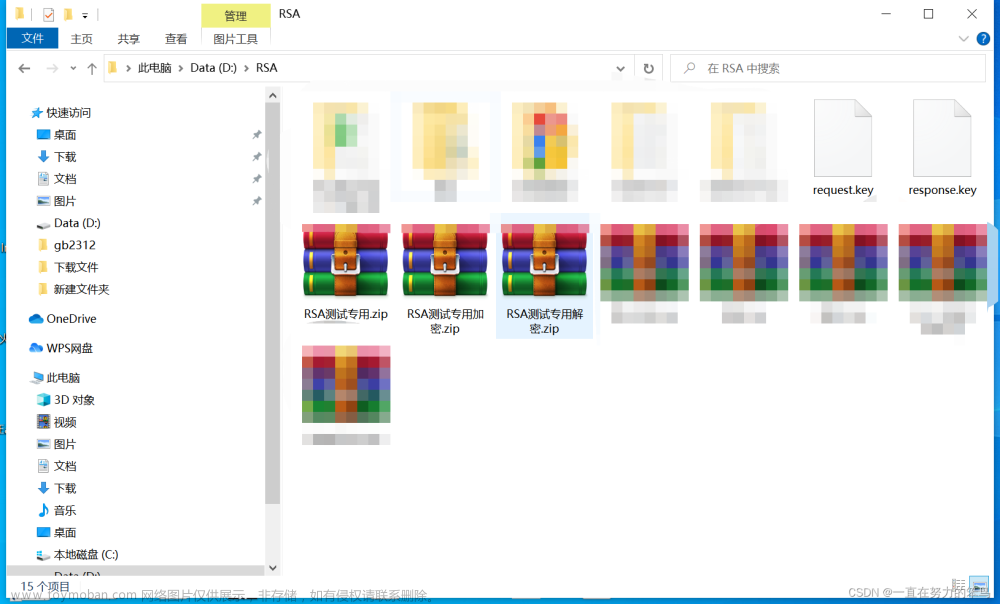1.简单快速集成,饮用hutool工具包实现
1)引入hutool包
<dependency>
<groupId>cn.hutool</groupId>
<artifactId>hutool-all</artifactId>
<version>5.8.8</version>
</dependency>2) 制作好自己的rsa公私钥文件,通过openssl实现即可,直接放到resources下面

3)读取rsa文件,进行加解密实现,公钥加密,私钥解密,注意点都在里面注释了。
package com.shebao.controller.wechat;
import cn.hutool.crypto.asymmetric.KeyType;
import cn.hutool.crypto.asymmetric.RSA;
import org.springframework.core.io.ClassPathResource;
import org.springframework.core.io.Resource;
import java.io.BufferedReader;
import java.io.FileReader;
import java.io.IOException;
public class HutoolRSATest {
public static void main(String[] args) throws IOException {
String en = testEncrypt();
testDecrypt(en);
}
/**
* 私钥解密
* @param content 加密了的内容
* @throws IOException
*/
public static void testDecrypt(String content) throws IOException {
Resource resource = new ClassPathResource("rsa_private_key.pem");
System.out.println(resource.getFile().getPath());
BufferedReader br = new BufferedReader(new FileReader(resource.getFile().getPath()));
/**
* 这个巨重要,会筛选掉密钥内容中的首行标识字段
*/
String s = br.readLine();
String str = "";
s = br.readLine();
while (s.charAt(0) != '-') {
str += s + "\r";
s = br.readLine();
}
RSA rsa = new RSA(str,null);
String s1 = rsa.decryptStr(content, KeyType.PrivateKey);
System.out.println(s1);
}
/**
* 公钥加密
* @return
* @throws IOException
*/
public static String testEncrypt() throws IOException {
String content = "这是糊涂工具包hutool";
Resource resource = new ClassPathResource("rsa_public_key.pem");
System.out.println(resource.getFile().getPath());
BufferedReader br = new BufferedReader(new FileReader(resource.getFile().getPath()));
String s = br.readLine();
String str = "";
s = br.readLine();
while (s.charAt(0) != '-') {
str += s + "\r";
s = br.readLine();
}
RSA rsa = new RSA(null,str);
String result = rsa.encryptBase64(content, KeyType.PublicKey);
System.out.println(result);
return result;
}
}
2.不借助工具,直接引用java security包实现功能
1)公私钥依然放在resources下
2)公钥加密,私钥解密
3)java.security.Security.addProvider( new org.bouncycastle.jce.provider.BouncyCastleProvider() );这句话很重要,不过别乱用,容易导致内存泄漏:可以参看如下文章
每次New一个BouncyCastleProvider导致的内存泄漏_shenhaiwen的博客-CSDN博客
我的实例改良了这里文章来源:https://www.toymoban.com/news/detail-694905.html
4)要注意base64的解码和编码文章来源地址https://www.toymoban.com/news/detail-694905.html
package com.shebao.controller.wechat;
import org.apache.commons.codec.binary.Base64;
import org.bouncycastle.jce.provider.BouncyCastleProvider;
import org.springframework.core.io.ClassPathResource;
import org.springframework.core.io.Resource;
import javax.crypto.Cipher;
import java.io.BufferedReader;
import java.io.FileReader;
import java.nio.charset.StandardCharsets;
import java.security.KeyFactory;
import java.security.PrivateKey;
import java.security.PublicKey;
import java.security.Security;
import java.security.spec.PKCS8EncodedKeySpec;
import java.security.spec.X509EncodedKeySpec;
public class TestRSA {
private static String content = "你好呀RSA";
public static void main(String[] args) throws Exception {
PublicKey publicKey = getPublicKey();
Cipher cipher = Cipher.getInstance("RSA");
cipher.init(Cipher.ENCRYPT_MODE, publicKey);
byte[] bytes = cipher.doFinal(content.getBytes());
byte[] bytes1 = Base64.encodeBase64(bytes);
String result = new String(bytes1,"utf-8");
System.out.println(result);
test(result);
}
public static void test(String en) throws Exception {
PrivateKey privateKey = getPrivate();
KeyFactory keyFactory1 = KeyFactory.getInstance("RSA");
Cipher cipher = Cipher.getInstance(keyFactory1.getAlgorithm());
cipher.init(Cipher.DECRYPT_MODE, privateKey);
byte[] bytes2 = cipher.doFinal(Base64.decodeBase64(en));
System.out.println(new String(bytes2, StandardCharsets.UTF_8));
}
public static PrivateKey getPrivate() throws Exception {
Resource resource = new ClassPathResource("rsa_private_key.pem");
System.out.println(resource.getFile().getPath());
BufferedReader br = new BufferedReader(new FileReader(resource.getFile().getPath()));
/**
* 这个巨重要,会筛选掉密钥内容中的首行标识字段
*/
String s = br.readLine();
/**
* 这里是读取的私钥文件
*/
String str = "";
s = br.readLine();
while (s.charAt(0) != '-') {
str += s + "\r";
s = br.readLine();
}
Base64 base64 = new Base64();
byte[] b = base64.decode(str);
/**
* 这个也是巨重要的,不信可以去了试试,也有另一种方式去解决这个问题,没试
*/
BouncyCastleProvider instance = getInstance();
if (Security.getProvider(instance.getName()) == null) {
java.security.Security.addProvider(
instance
);
}
// 生成私匙
KeyFactory kf = KeyFactory.getInstance("RSA");
PKCS8EncodedKeySpec keySpec = new PKCS8EncodedKeySpec(b);
PrivateKey privateKey = kf.generatePrivate(keySpec);
return privateKey;
}
public static PublicKey getPublicKey() throws Exception {
Resource resource = new ClassPathResource("rsa_public_key.pem");
System.out.println(resource.getFile().getPath());
BufferedReader br = new BufferedReader(new FileReader(resource.getFile().getPath()));
String s = br.readLine();
/**
* 这里是读取的公钥文件
*/
String public_key = "";
s = br.readLine();
while (s.charAt(0) != '-') {
public_key += s + "\r";
s = br.readLine();
}
Base64 base64 = new Base64();
byte[] decode = base64.decode(public_key);
X509EncodedKeySpec keySpec = new X509EncodedKeySpec(decode);
KeyFactory keyFactory = KeyFactory.getInstance("RSA");
PublicKey publicKey = keyFactory.generatePublic(keySpec);
return publicKey;
}
private static org.bouncycastle.jce.provider.BouncyCastleProvider bouncyCastleProvider = null;
public static synchronized org.bouncycastle.jce.provider.BouncyCastleProvider getInstance() {
if (bouncyCastleProvider == null) {
bouncyCastleProvider = new org.bouncycastle.jce.provider.BouncyCastleProvider();
}
return bouncyCastleProvider;
}
}
到了这里,关于RSA 公私钥加解密Java实现的文章就介绍完了。如果您还想了解更多内容,请在右上角搜索TOY模板网以前的文章或继续浏览下面的相关文章,希望大家以后多多支持TOY模板网!







